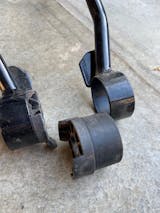I'm going to start out by saying that I love the concept of this bike rack. Hitch-mounted, tray racks are awesome for easily and securely carrying a wide variety of bikes. And Yakima made a rack which is easy to install and use. However, due to some design oversights, they have not engineered the highest quality product, so after 9 months of light to moderate use, my HoldUp Evo has broken. I purchased the rack at the end of September 2019 to transport my full-suspension mountain bike, and I used it about 5 times before winter came and I stopped biking for the season. I stored my bike rack inside my garage all winter long. In May 2020, when biking season came back around, I started to use the rack again. I used it about 12 times in May with no issues, and then decided to take the rack on a road trip across the US for approximately 4 weeks. Normally I take the rack off of my car after each use, but for the road trip both the rack and 2 bikes were living on the back of the car. About 2 weeks into the trip, after a day of riding, I was unfolding my rack to put the bikes back on and I heard a pop. A plastic piece fell off the bike rack, and after some investigation I discovered that it was the through axle used for rotating the front basket and wheel-holder of the rack. I am not quite sure how this happened, because I was unfolding the rack as I always do and did not encounter anything unusual in the process, such as resistance to rotating. So now I was halfway through a road trip with 2 bikes and a bike rack which was half-broken. Using some duct tape I was able to successfully limp the rack through the rest of the trip. When I got home I disassembled the rack to see what actually happened to it, and I found some frustrating oversights in the design of the rack. Most of this bike rack is constructed using metal components (not clear on what material is used, maybe a steel or aluminum alloy), which are a bit heavy and seem quite robust. However, there are a few key components which Yakima opted to construct using plastic (also not clear what exact materials, but some hard plastic), and I am not sure why these parts were chosen to be plastic as opposed to metal. The most obviously flawed piece is the plastic through axle which broke on my rack. This is a crucial piece for proper and safe functioning of the bike rack, but it is not very strong. As mentioned, the front wheel basket and wheel holder rotate around this piece to fold up and store, and this piece also holds the wheel basket and wheel holder together with the main beam of the bike rack. It is approximately 3/4" in diameter. Additionally, there is a roughly 1/2" hole drilled directly through this plastic piece perpendicular to the direction of the axle, where a bolt slides through to hold the through axle in place. You don't need to be an engineer to understand that drilling such a large hole through this piece will compromise its integrity, and therefore reduce the material's overall strength. Well, right along this hole is where my through axle sheared into two pieces (see picture). I understand the concept of using plastic as a replacement material for easier construction and weight savings, but for such an expensive, heavy, and seemingly robust bike rack, this was not a smart design choice. Additionally, there are plastic pieces used to fit the front wheel basket onto the main support piece. When the plastic through axle broke, part of these plastic pieces also sheared (see red circle in picture), which illustrates another poor material choice for more important moving pieces on the rack. These two parts are some of the only plastic used on the rack (aside from less integral parts), which begs the question as to why they are plastic. I try to keep my bike rack as clean as possible, and I always wash it and lubricate the moving parts after use (as Yakima recommends for their racks). Somehow this rack still managed to break in under a year though. I have called to request new parts to fix the rack, but honestly I think that I will be replacing these pieces with some custom built metal alternatives, to avoid having this issue in the future. For a $550 bike rack, I honestly expected higher quality construction and a longer life.































































